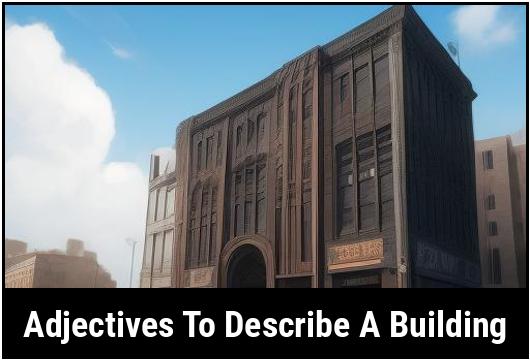- You are here:
- Home »
- adjectives
- » 31 Adjectives To Describe A Building

31 Adjectives To Describe A Building
When exploring a building or trying to convey its characteristics, adjectives play an essential role in painting a vivid picture for the audience. Whether it’s a description of an architectural marvel, a historic landmark, or a modern skyscraper, the use of appropriate adjectives can add depth and texture to the portrayal of the building. This article delves into the various types of adjectives available to describe buildings, providing insight into how to choose the right adjectives and presenting a comprehensive list of descriptive words to capture the essence of any structure.
Key Takeaways
- Adjectives are crucial for providing detailed and vivid descriptions of buildings, enhancing the reader’s understanding and visualization.
- The use of adjectives can evoke emotions, convey a building’s history, architecture, and aesthetics, and create a distinct mental image for the audience.
- Choosing the right adjectives depends on the specific attributes, characteristics, and purpose of the building being described.
Adjectives To Describe A Building
1. Majestic
Some buildings possess an awe-inspiring presence that can leave us breathless. Describing a building as majestic highlights its grandeur, magnificence, and ability to dominate its surroundings. Think of ancient castles, grand palaces, or cathedrals with towering spires that exude a sense of power and elegance.
2. Modern
In contrast to historic structures, modern buildings adopt cutting-edge design, ingenuity, and technology. Describing a building as modern emphasizes its contemporary aesthetic, technological advancements, and sleek lines. These buildings often represent progress and innovation in architecture.
3. Architectural
Buildings that are described as architectural are distinguished and noteworthy in terms of design and construction. This adjective emphasizes the artistic and creative aspects of a structure, highlighting its unique features, intricate detailing, or unconventional forms that push the boundaries of conventional architecture.
4. Elegant
An elegant building exudes grace, refinement, and sophistication. This adjective is used to describe structures with harmonious proportions, tasteful ornamentation, and a timeless sense of style. Elegant buildings often stand out effortlessly, blending beauty and functionality seamlessly.
5. Charming
Charming buildings possess a delightful and appealing character that captivates us with their unique charm. These structures often have whimsical details, colorful facades, or an inviting atmosphere that evokes a sense of warmth and joy. From quaint cottages to picturesque cafes, charming buildings have the power to create a lasting impression.
6. Impressive
When a building is described as impressive, it evokes a feeling of astonishment and admiration. These structures are often characterized by their size, scale, or extraordinary architectural features. Whether it’s a towering skyscraper or a colossal ancient monument, impressive buildings leave us marveling at their sheer magnitude.
7. Iconic
Certain buildings become symbols of a city or a country, representing their culture, heritage, or significance. Describing a building as iconic acknowledges its status as a recognizable landmark that holds historical importance or cultural significance. Iconic buildings are often visited and photographed by tourists from all over the world.
8. Stately
To describe a building as stately is to emphasize its dignified and regal presence. These structures often have imposing facades, ornate details, and a sense of gravitas. Stately buildings can be seen in government buildings, historic mansions, or prestigious institutions.
9. Sustainable
In an era where environmental consciousness is crucial, sustainable buildings are gaining prominence. Describing a building as sustainable highlights its eco-friendly design, energy efficiency, and use of renewable materials. These structures demonstrate a commitment to preserving the environment and achieving long-term sustainability.
10. Functional
The functionality of a building is an essential aspect to consider. Describing a building as functional acknowledges its efficiency, practicality, and ability to serve its intended purpose effectively. From office buildings designed to optimize productivity to homes that provide comfort and livability, functional buildings play a crucial role in our daily lives.
11. Innovative
Innovation is a driving force in architecture, pushing the boundaries of what is possible. Describing a building as innovative acknowledges its creative use of materials, groundbreaking design concepts, or incorporation of cutting-edge technology. These buildings often become symbols of progress and represent the visionary minds behind their creation.
12. Striking
Some buildings stand out from the crowd, effortlessly catching the eye with their extraordinary appearance. Describing a building as striking captures its ability to make an impact and create a lasting impression. Striking buildings often feature unique colors, bold shapes, or captivating facades that demand attention wherever they are located.
13. Welcoming
Welcoming buildings have an inviting and inclusive atmosphere that makes people feel comfortable and at ease. Whether it’s a cozy café or a community center, describing a building as welcoming emphasizes its ability to create a sense of belonging and warmth. These structures often serve as gathering places for individuals to come together and connect.
14. Historical
Buildings steeped in history have a unique charm and significance. Describing a building as historical acknowledges its age, preservation of the past, and the stories it carries within its walls. Historical buildings often serve as reminders of a bygone era, allowing us to connect with our collective heritage.
15. Futuristic
Futuristic buildings transport us into the realm of science fiction and imagination. Describing a building as futuristic highlights its unconventional design, use of advanced technology, and visionary concepts. These structures often push the boundaries of what we perceive as architectural possibilities, giving us a glimpse into a future that awaits.
16. Unique
Certain buildings possess an unparalleled uniqueness that sets them apart from the rest. Describing a building as unique highlights its one-of-a-kind features, unconventional design, or distinct character. Unique buildings often become icons themselves, leaving a lasting impression on all who encounter them.
17. Harmonious
Harmonious buildings blend effortlessly into their surroundings, creating a sense of balance and unity. Describing a building as harmonious acknowledges its integration with the natural or urban landscape, its complementary design elements, and its ability to enhance the aesthetic appeal of its environment.
18. Eclectic
Eclectic buildings draw inspiration from different architectural styles, resulting in an interesting fusion of elements. Describing a building as eclectic emphasizes its diverse influences, mixing traditional and modern designs or combining elements from different eras or cultures. These buildings often reflect a rich tapestry of architectural history.
19. Welcoming
Welcoming buildings have an inviting and inclusive atmosphere that makes people feel comfortable and at ease. Whether it’s a cozy café or a community center, describing a building as welcoming emphasizes its ability to create a sense of belonging and warmth. These structures often serve as gathering places for individuals to come together and connect.
20. Minimalist
In contrast to opulent and intricate buildings, minimalist structures adopt a less-is-more approach. Describing a building as minimalist emphasizes its simplicity, clean lines, and focus on essential elements. These understated buildings often create a sense of tranquility and promote a clutter-free environment.
21. Vibrant
Vibrant buildings burst with energy, color, and life. Describing a building as vibrant highlights its vivid facades, bold patterns, or playful use of colors. These structures add vibrancy and dynamism to their surroundings, creating a visual feast for the eyes.
22. Invigorating
Invigorating buildings have a rejuvenating and energizing effect on their occupants. Whether it’s through the use of natural light, open spaces, or greenery, describing a building as invigorating emphasizes its ability to uplift and inspire. These structures promote well-being and productivity, creating an environment that encourages growth.
23. Serene
Serene buildings exude peace, tranquility, and a sense of calm. Describing a building as serene emphasizes its harmonious design, use of natural elements, or contemplative spaces. These structures provide refuge from the chaos of the outside world, allowing individuals to find solace and inner peace.
24. Accessible
Accessible buildings are designed to accommodate individuals of all abilities, ensuring inclusivity for everyone. Describing a building as accessible acknowledges its thoughtful design considerations, such as ramps, elevators, and wide entrances. These structures promote equal access and independence, fostering a sense of equality and dignity.
25. Sustainable
In an era where environmental consciousness is crucial, sustainable buildings are gaining prominence. Describing a building as sustainable highlights its eco-friendly design, energy efficiency, and use of renewable materials. These structures demonstrate a commitment to preserving the environment and achieving long-term sustainability.
26. Welcoming
Welcoming buildings have an inviting and inclusive atmosphere that makes people feel comfortable and at ease. Whether it’s a cozy café or a community center, describing a building as welcoming emphasizes its ability to create a sense of belonging and warmth. These structures often serve as gathering places for individuals to come together and connect.
27. Dynamic
Dynamic buildings possess a sense of movement, energy, and change. Describing a building as dynamic highlights its unconventional forms, fluid lines, or innovative structural features. These structures captivate the imagination and inspire creativity, serving as symbols of progress and dynamism.
28. Cozy
Cozy buildings radiate warmth, intimacy, and a sense of homeliness. Describing a building as cozy emphasizes its snug spaces, comfortable interiors, and inviting atmosphere. These structures provide a haven where one can seek comfort and relaxation, creating a sense of contentment.
29. Resilient
In times of adversity and challenges, resilient buildings stand tall and withstand the test of time. Describing a building as resilient acknowledges its ability to endure the forces of nature, adapt to changing circumstances, or recover from difficult situations. These structures become symbols of resilience, reminding us of our own strength and perseverance.
30. Memorable
Memorable buildings make a lasting impression on our minds and hearts. Describing a building as memorable acknowledges its ability to leave a mark through its extraordinary design, unique features, or emotional impact. These structures become landmarks in our memories, forever etching themselves into our experiences.
31. Inspirational
Inspirational buildings go beyond their physical presence, and touch our souls. Describing a building as inspirational emphasizes its ability to evoke emotions, spark creativity, or challenge conventions. These structures become beacons of inspiration, pushing us to dream, innovate, and strive for greatness.
Why Use Adjectives To Describe A Building
Adjectives are fundamental tools for succinctly and effectively communicating the unique qualities and attributes of a building. They enable individuals to express a building’s appearance, style, and atmosphere in a manner that captivates the audience’s imagination. Through the use of adjectives, writers, architects, real estate professionals, and enthusiasts alike can convey the grandeur, elegance, and functionality of a building, ensuring that its essence is comprehensively portrayed.
By employing adjectives, one can articulate the architectural features, historical significance, and overall aesthetic appeal of a building. Furthermore, adjectives can infuse descriptions with emotions, allowing for a more profound connection between the audience and the building being depicted.
How To Choose The Right Adjective To Describe A Building
Selecting the appropriate adjectives to describe a building necessitates a thorough understanding of the building’s characteristics, purpose, and historical context. Several considerations should be taken into account when choosing adjectives to ensure a comprehensive and evocative description:
Understanding Building Characteristics
Before selecting adjectives, it’s crucial to comprehend the physical attributes of the building. This may encompass its size, shape, materials, design, and architectural elements. Furthermore, understanding the building’s purpose, such as whether it’s a residential structure, commercial edifice, or cultural landmark, is paramount in choosing suitable adjectives.
Recognizing Historical And Cultural Significance
For buildings with historical or cultural importance, it’s imperative to consider the era in which they were constructed, their relevance to a particular architectural style, and their impact on the surrounding environment. Adjectives that capture the historical and cultural relevance of the building should be selected with care, ensuring that they reflect its significance accurately.
Portraying Aesthetic And Emotional Appeal
In conveying the aesthetic and emotional appeal of a building, adjectives play a pivotal role. Descriptors that evoke emotions and create a sensory experience for the audience should be chosen thoughtfully, taking into account the ambiance, visual allure, and overall impact of the building.
Types Of Adjectives For Describing A Building
The comprehensive list of adjectives for describing a building is categorized into various types based on their relevance to different aspects of a building. These types include adjectives pertaining to architectural style, size, age, material, condition, and emotional and aesthetic appeal, among others.
Adjectives Describing Architectural Style
- Baroque: Characterized by ornate detail and grandeur.
- Minimalist: Reflecting simplicity and clean lines.
- Art Nouveau: Conveying intricate organic designs and decorative elements.
- Brutalist: Exhibiting raw concrete surfaces and bold geometric forms.
- Neo-classical: Evoking classical architectural elements and symmetry.
- Postmodern: Expressing eclecticism and experimentation in design.
Adjectives Describing Size
- Colossal: Indicating immense size and grandeur.
- Petite: Suggesting small and delicate proportions.
- Spacious: Reflecting ample room and open areas.
- Compact: Conveying a small and efficient layout.
- Vast: Indicating extensive space and expansiveness.
Adjectives Describing Age
- Ancient: Signifying great age and historical significance.
- Modern: Indicating contemporary design and recent construction.
- Historic: Reflecting historical importance and enduring relevance.
- Antique: Conveying an old and valuable quality.
- Timeless: Suggesting enduring appeal and relevance across different eras.
Adjectives Describing Material
- Glass: Reflecting transparency and modernity.
- Stone: Conveying solidity and traditional craftsmanship.
- Steel: Suggesting strength and industrial aesthetic.
- Brick: Indicating durability and classic construction.
- Wooden: Signifying warmth and natural aesthetics.
Adjectives Describing Condition
- Dilapidated: Indicating decay and disrepair.
- Immaculate: Reflecting pristine and flawless condition.
- Weathered: Suggesting age and exposure to the elements.
- Sturdy: Conveying durability and robustness.
- Polished: Reflecting a gleaming and well-maintained appearance.
Adjectives Describing Emotional And Aesthetic Appeal
- Inspiring: Conveying a sense of motivation and uplifting qualities.
- Majestic: Signifying grandeur, dignity, and impressive beauty.
- Ethereal: Reflecting a delicate and otherworldly charm.
- Stunning: Suggesting a striking and visually captivating presence.
- Serene: Conveying a tranquil and peaceful ambiance.
Adjectives Describing Historical And Cultural Significance
- Landmark: Indicating a structure of great historical or cultural significance.
- Iconic: Reflecting widespread recognition and symbolic importance.
- Heritage: Conveying traditional and historical value.
- Milestone: Suggesting a building’s pivotal role in history or development.
- Revolutionary: Signifying a structure that ushered in significant change or innovation.
The use of adjectives to describe buildings is indispensable for conveying their unique characteristics, historical significance, and emotional and aesthetic appeal. Adjectives enable individuals to create vivid and evocative portrayals of buildings, fostering a deeper understanding and appreciation of their architectural and cultural significance. By choosing the right adjectives that align with a building’s attributes and purpose, a comprehensive and compelling description can be crafted, enriching the audience’s perception and creating a lasting impression of the building in question. Whether it’s an ancient monument or a contemporary masterpiece, the selection of appropriate adjectives elevates the depiction of a building, allowing its essence to be truly captured and appreciated.
Examples Of Adjectives For Different Types Of Buildings
When describing a building, choosing the right adjectives is essential to effectively convey its characteristics and create an engaging description. Adjectives add depth and detail to your writing, allowing readers to visualize the building and understand its unique qualities.
-
Residential Buildings:
- Cozy: A small residential building that offers a warm and intimate atmosphere.
- Spacious: A residential building with ample room and open areas.
- Elegant: A stylish and sophisticated residential building that exhibits refined taste.
- Modern: A contemporary residential building with sleek design and cutting-edge features.
- Quaint: A charming residential building that exudes a sense of old-world charm.
-
Commercial Buildings:
- Corporate: A commercial building that is designed to cater to business needs, with professional aesthetics.
- Impressive: A commercial building that commands attention and leaves a lasting impact.
- Functional: A commercial building that is efficiently designed and well-suited for business operations.
- High-rise: A tall commercial building with multiple floors and an imposing presence.
- State-of-the-art: A commercial building equipped with the latest technology and amenities.
-
Historical Buildings:
- Grand: A historical building of substantial size and architectural magnificence.
- Ornate: A historical building adorned with intricate decorative details.
- Stately: A historical building that exudes dignity, grace, and importance.
- Timeless: A historical building that transcends eras and retains its allure indefinitely.
- Majestic: A historical building that inspires awe and reverence.
-
Educational Buildings:
- Innovative: An educational building that embraces new and creative approaches to learning.
- Collaborative: An educational building designed to foster collaboration and teamwork.
- Inspiring: An educational building that ignites curiosity and motivates learners.
- Sustainable: An educational building that prioritizes environmental consciousness and resource efficiency.
- Technologically advanced: An educational building equipped with state-of-the-art technology and resources.
-
Religious Buildings:
- Serene: A religious building that emanates peace, tranquility, and spirituality.
- Sacred: A religious building that is considered holy or dedicated to divine worship.
- Majestic: A religious building that evokes a sense of awe and reverence.
- Spiritual: A religious building that encourages introspection, contemplation, and connection to a higher power.
- Architecturally intricate: A religious building characterized by complex and detailed architectural elements.
-
Government Buildings:
- Official: A government building that serves as an official center for administrative functions.
- Monumental: A government building that symbolizes authority, power, and national importance.
- Impenetrable: A government building that is fortified and designed to withstand threats.
- Functionally designed: A government building that is optimized for efficient operation and meeting the needs of its purpose.
- Bureaucratic: A government building that embodies the bureaucratic nature of administrative processes.
These are just a few examples of adjectives that can be used to describe different types of buildings. However, the possibilities are endless, and you can mix and match adjectives to create unique and compelling descriptions.
Common Mistakes In Using Adjectives To Describe Buildings
While adjectives can enhance a description, it’s important to use them correctly to avoid common mistakes that can undermine the impact of your writing. Here are some mistakes to avoid when using adjectives to describe buildings:
-
Overusing adjectives: Using too many adjectives in a description can make it feel cluttered and overwhelming. Instead, choose a few impactful adjectives that succinctly capture the essence of the building.
-
Vague adjectives: Using generic or vague adjectives can weaken the description. Instead, opt for specific and descriptive adjectives that provide a clear and vivid image.
-
Unrealistic adjectives: Avoid using adjectives that are unrealistic or exaggerate the qualities of the building. Stay true to the building’s actual characteristics rather than creating an unrealistic portrayal.
-
Inconsistent adjectives: Ensure that your adjectives align with the overall tone and style of the description. Consistency in adjectives creates a cohesive and harmonious description.
-
Ignoring context: Consider the context in which the building exists and tailor your adjectives accordingly. A residential building in a bustling city will have different adjectives compared to one located in a rural area.
By avoiding these common mistakes, you can ensure that your descriptions are accurate, engaging, and impactful.
Using Adjectives Effectively
To make the most out of your adjectives and create compelling descriptions of buildings, consider the following tips:
-
Visualize the building: Before describing a building, take a moment to visualize it in your mind. Note down the distinctive features, architectural style, color, and overall ambiance. This visualization will help you select adjectives that capture the building’s essence more effectively.
-
Be specific and precise: Choose adjectives that provide specific and precise information. Instead of using generic terms like "nice" or "beautiful," select adjectives that paint a more detailed picture and allow readers to form a clear mental image.
-
Use sensory language: Incorporate sensory language in your descriptions to engage the readers’ senses. Describe how the building looks, sounds, smells, feels, and even tastes if applicable. This adds depth and realism to your descriptions.
-
Consider the audience and purpose: Tailor your choice of adjectives to your intended audience and the purpose of your description. For example, if you are describing a building to attract potential buyers, focus on highlighting its desirable features and amenities.
-
Blend adjectives with other language techniques: Enhance your descriptions by combining adjectives with other language techniques such as metaphors, similes, and vivid language. This creates a more memorable and vivid description.
-
Edit and revise: After writing your description, review it to ensure that each adjective enhances the overall impact. Remove any unnecessary or redundant adjectives and refine your language for clarity and precision.
By following these tips, you can create descriptions that captivate readers and bring buildings to life on the page.
Exercises And Practice
To strengthen your skills in using adjectives to describe buildings, here are some exercises and practice activities:
-
Building Description Game: Take a walk or drive around your city or neighborhood and choose a building to describe. Note down all the details you observe, and then challenge yourself to come up with at least five adjectives to describe the building accurately and creatively. Share your description with a friend or family member and compare your choices.
-
Adjective Swap: Find a piece of descriptive writing that includes adjectives to describe a building. Identify the adjectives used and experiment with replacing them with alternative adjectives. Consider how the new adjectives change the overall impact and tone of the description.
-
Adjective Sorting: Create a list of adjectives and categorize them according to the type of building they best describe. For example, group adjectives that are suitable for residential buildings, commercial buildings, historical buildings, etc. This activity will help you familiarize yourself with a variety of adjectives and their specific applications.
-
Rewrite Descriptions: Find existing descriptions of buildings, such as those found in travel magazines or online listings, and challenge yourself to rewrite them using your own choice of adjectives. Compare your descriptions with the original and reflect on the different effects each conveys.
-
Peer Review: Exchange building descriptions with a classmate or writing partner. Review each other’s descriptions and provide constructive feedback on the clarity, impact, and effective use of adjectives. Discuss the adjectives chosen and suggest possible alternatives or enhancements.
Conclusion
Choosing the right adjectives to describe buildings enables you to create vivid, engaging, and accurate descriptions that captivate readers’ attention. By considering the type of building, being specific and precise, and using sensory language, you can effectively convey the unique qualities of a building. By practicing with exercises and avoiding common mistakes, you can refine your skills in using adjectives and create descriptions that leave a lasting impression. So go ahead and experiment with adjectives to create compelling descriptions of buildings that transport your readers to architectural wonders.
FAQS On Adjectives To Describe A Building
What Are Some Common Adjectives Used To Describe A Building’s Appearance?
Some common adjectives used to describe a building’s appearance are modern, historic, spacious, elegant, and grand.
Can You Give Examples Of Adjectives That Portray A Building’s Style?
Sure, some examples of adjectives that portray a building’s style are Gothic, Art Deco, Renaissance, Victorian, and Contemporary.
How Do You Describe A Building’s Structure Using Adjectives?
A building’s structure can be described using adjectives such as sturdy, tall, angular, symmetrical, and ornate.
Which Adjectives Are Often Used To Describe The Interior Of A Building?
Adjectives that are often used to describe the interior of a building include cozy, luxurious, open, inviting, and well-designed.
What Adjectives Can Be Used To Convey The Atmosphere Or Feeling Of A Building?
Adjectives that can convey the atmosphere or feeling of a building are welcoming, majestic, intimate, vibrant, and serene.








